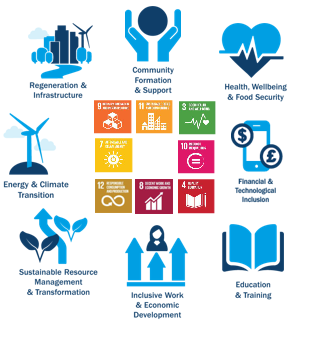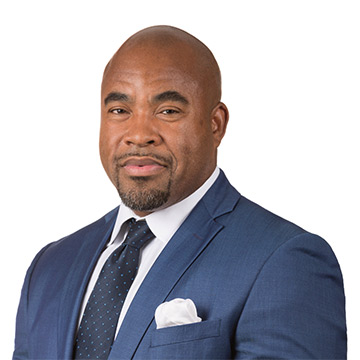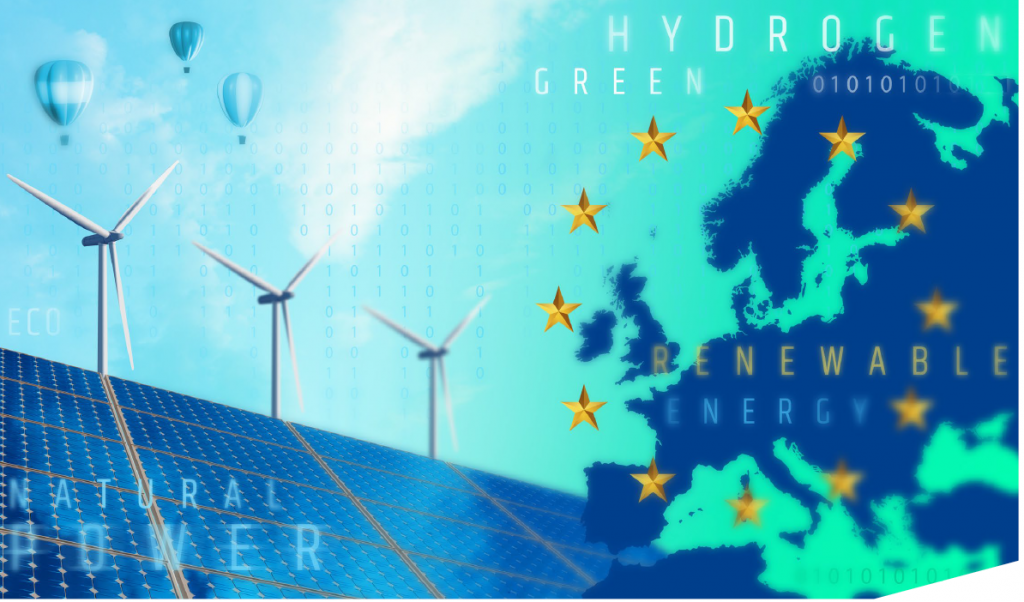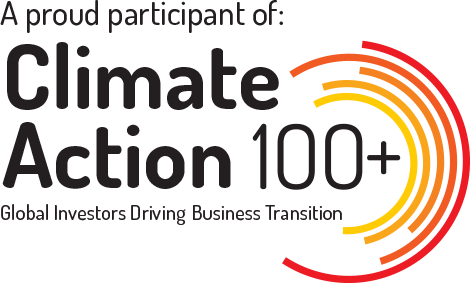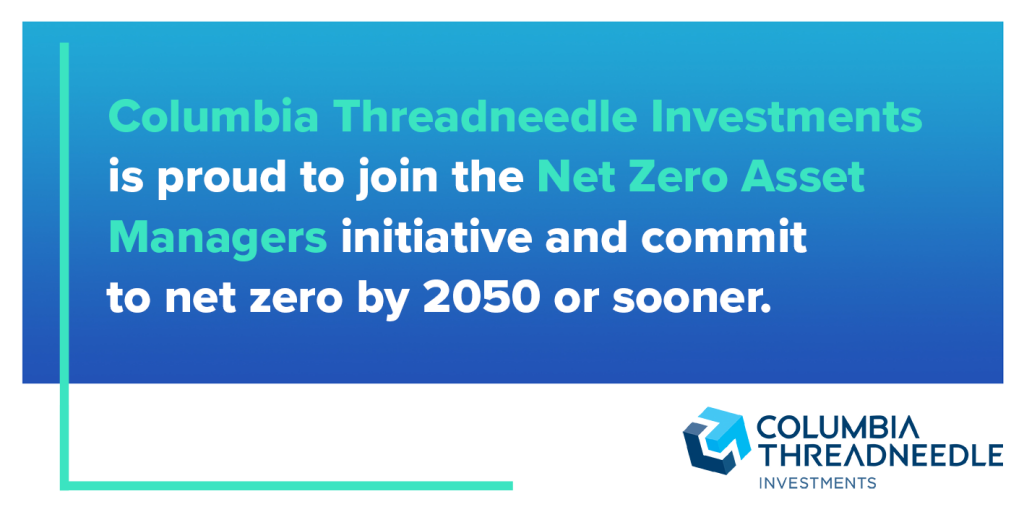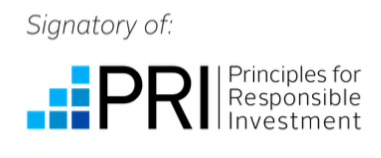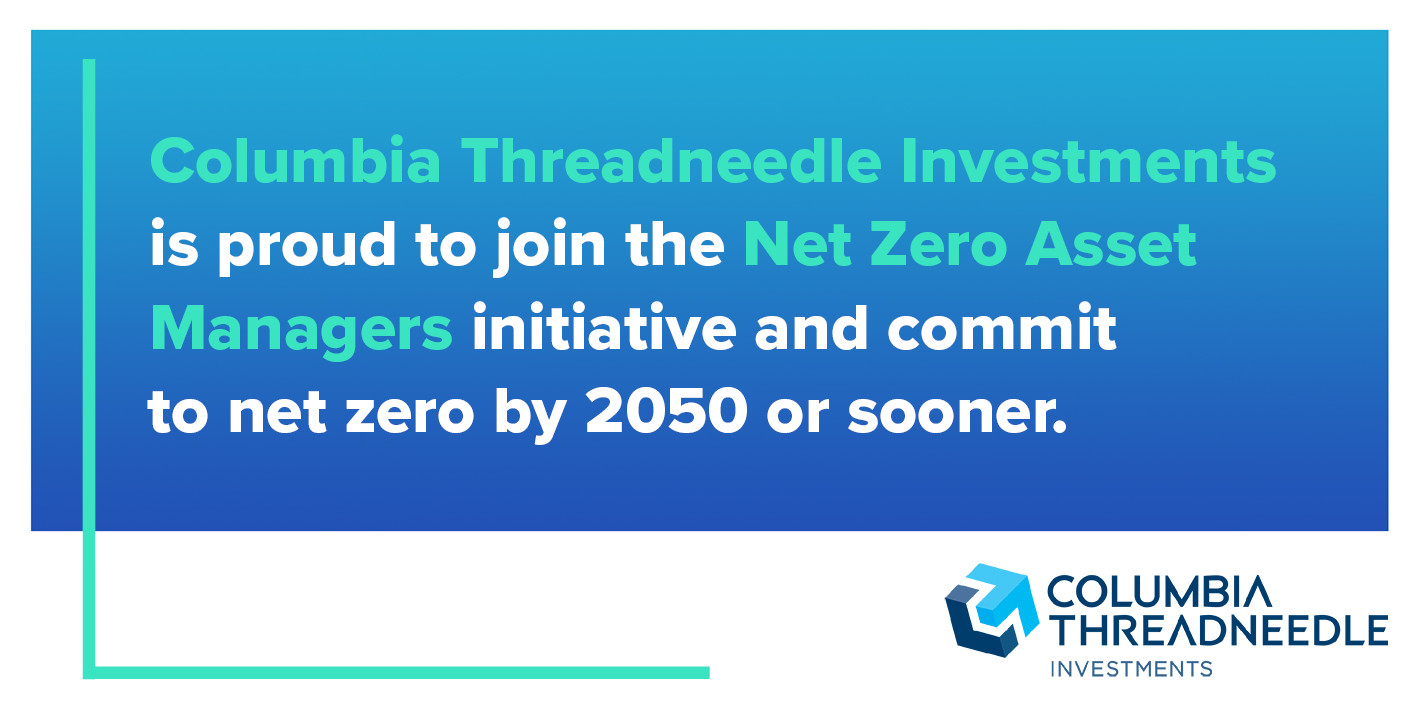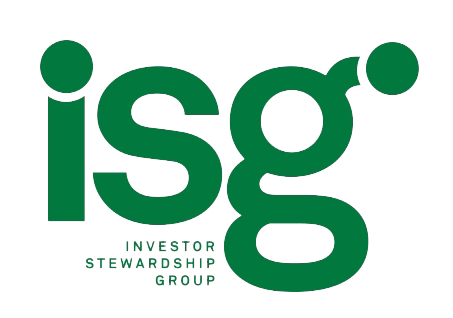About us
Responsible investment
In a world where a genuine responsible investment partner is increasingly crucial, Columbia Threadneedle Investments aims to help investors move forward more confidently. With an even stronger commitment, and even greater strength of expertise, we are well positioned to support clients evolving needs.
Breadth of capability and depth of expertise in Responsible Investment
We strive to be responsible stewards of our clients’ assets, allocating their capital within a framework of robust research and good governance, with a breadth of capability, and depth of expertise. Our industry leading resources provide deeper research, powerful analytics, and smarter insights, which enriches our knowledge on environmental, social and governance issues across asset classes, sectors and geographies.
We are active owners
Active ownership is central to our work. We recognise the positive role we can play as investors in driving real world change through our activities. Thoughtful engagement helps us to develop a more accurate understanding of a company. By building trust, we can have greater influence, drive positive change, reduce risk and enhance long-term performance. We have a 20-year track record of active ownership.
Award winning Responsible strategies and solutions
We have an extensive range of award-winning responsible strategies and solutions. Our evolving range includes all asset classes and covers the responsible investment fund spectrum. We continue to innovate to answer clients evolving need. Our reo™ service gives investors access to market leading engagement and proxy voting services.
Driving change
Investing responsibly is not a new idea for us. We were one of the earliest adopters of the UN Principles for Responsible Investment and launched Europe’s first ethically screened equity and the UK’s social bond funds. We’ve been at the forefront of active ownership – engaging with companies for over 20 years, helping shape industry policies and standards.
It comes from a belief that applying responsible investment principles can reduce risk and enhance outcomes over the long term. It’s an ethos that continually pushes us forward to drive change through a more responsible investment approach – for us, our clients, and the wider world.
RI Research and ESG Integration
At Columbia Threadneedle identifying the financially material impact of ESG issues is integral to our investment process. It provides a clearer understanding of both risk and long-term opportunity.
ESG considerations are integrated to varying degrees throughout the investment process.
Our 130-strong global research team, which includes ESG thematic analysts, focus solely on finding original and actionable insights. They focus on key sustainability themes which we think are most investment-relevant and are aligned to the globally recognised UN Sustainable Development Goals.
Thematic analysts educate investment teams, collaborate with them to identify risks and opportunities, and engage with companies to enhance research insights.
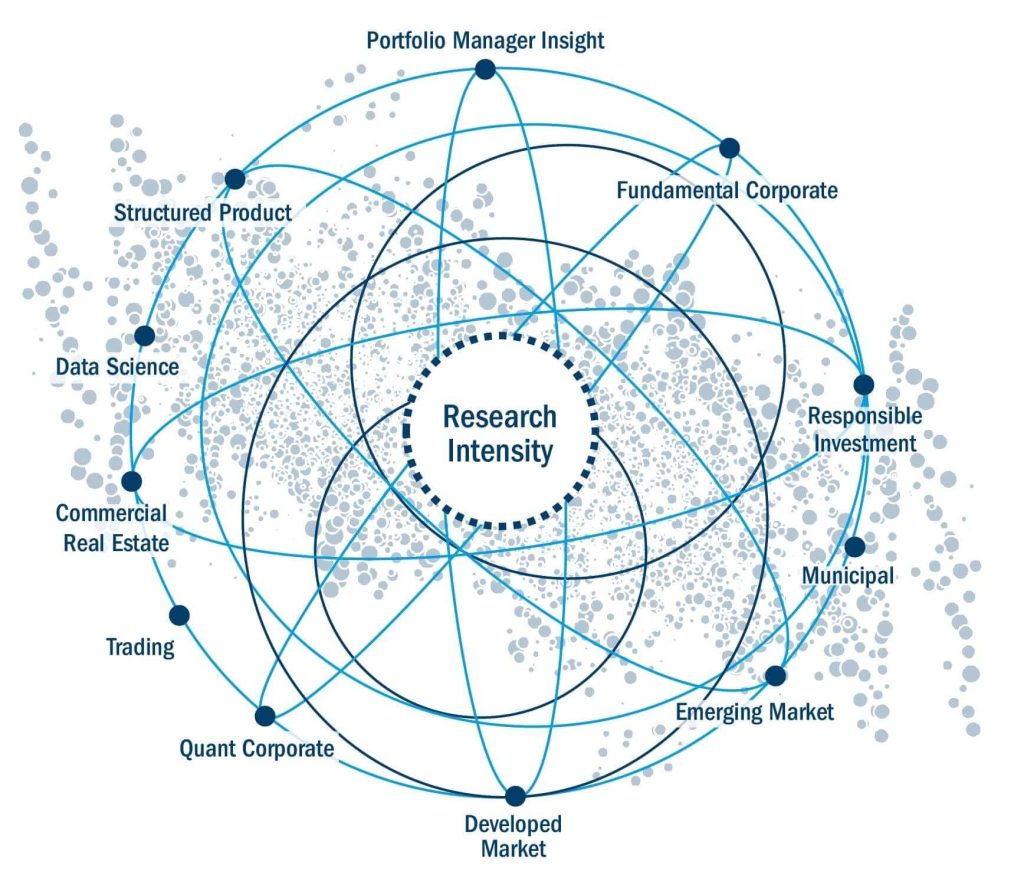
Our suite of ESG analytics below provide investment teams with a robust framework to assess material ESG risks and opportunities for thousands of companies worldwide. The analytics support our forward-looking research and help inform investment decision making and prioritise engagements. We are constantly evolving our analytics to better assess ESG risks – and to enable transparency with clients.
These industry-leading resources provide deeper research, powerful analytics, and smarter insight. They enrich our knowledge of ESG issues across asset classes, sectors and geographies. This breadth of capability, and depth of expertise, forms a Centre of Excellence in Responsible Investment, enabling us to deliver a range of funds and solutions to meet our clients’ evolving requirements.
View our latest Responsible Investment Quarterly report here:
View previous reports:
Nuclear power(ing up) – opportunities for investors
COP29: Will it deliver on climate finance?
Power hungry AI - investment implications in the era of energy transition
Active ownership
We are active owners, using considered engagement and thoughtful voting to reduce risk and enhance long-term performance. Active ownership can also be a powerful driver of positive change, influencing the activities and behaviour of investee companies for the better.
We identify ESG issues of strategic importance to companies we invest in and their wider impact on the world. We engage in dialogue on the management of those issues to ensure sufficient strategic focus from the business; to ensure strong oversight; to raise the issue up the agenda; to encourage positive change. We use escalation tools where necessary. It can take time to build consensus for change within a business and to develop the tools to do so. We support companies on that journey, and we hold them to account on their commitments.
Responsible Engagement Overlay (reo®) service
Active ownership is a key cornerstone of our work and is provided to third party companies through our pioneering reo® service. Through reo®, clients enjoy greater influence to effect positive change by pooling assets to create one single, powerful voice. We proudly represent a global client base of investors including pension funds, insurers, asset managers, fiduciary managers, charities, and family offices.
Engagement with depth and breadth
Engagement is at the heart of everything we do. Because our 22-strong team of engagement analysts specialise by theme and industry, we see the issues in context, providing a greater depth of understanding. Our combined organisation further enriches the depth of our expertise.
Climate change
We consider climate change to be one of the defining issues of our generation, and fully support the goals of the Paris agreement. We continue to evolve our research and data analytics, and engagement focus around climate change, acknowledging that there are meaningful risks but also investment opportunities to be captured in a world transitioning to net zero emissions. Central to our fundamental research of companies is an assessment of the credibility and achievability of a company’s carbon transition plan.
We are members of the Net Zero Asset Managers initiative, a group of asset managers committed to supporting the goal of net zero greenhouse gas emissions by 2050 or sooner. We have developed a robust framework to measure and monitor carbon emissions. We are working on an ambitious approach to address the climate impact of both our own business activities and our invested assets, through close partnership with our clients and the companies we invest in, under the framework recommended by the Taskforce on Climate-related Financial Disclosures (TCFD). Our approach has a focus on real-world emissions reduction, engaging with companies to help them on their decarbonisation journeys. We are also a signatory to Climate Action 100+ (CA100+), a collaborative program seeking to ensure that the world’s largest corporate greenhouse gas emitters take necessary action to combat climate change.
See below for more details on our climate approach and methodology.
Investment solutions
Responsible Investing is increasingly important to investors. Many are looking to invest their money in a way that aligns with their values and to drive positive, real-world change. We have a long history of investing responsibly; In 1984 we launched our Responsible UK Equity fund – Europe’s first social and environmentally screened fund. In 2014 we launched the UK’s first daily liquid social bond strategy, and we’ve built out the franchise with European and US-based strategies. Our responsible range also includes Global, UK and Pan-European Sustainable Outcomes Strategies, Sustainable Infrastructure and Carbon Neutral Real Estate as well as Responsible Global Equity, Sustainable Opportunities and SDG Engagement Global Equity Strategies amongst others. We continue to innovate, creating award-winning strategies that embrace different responsible priorities and approaches across the RI spectrum.
To search our range of responsible funds available in your region click here.
Responsible Engagement Overlay (reo) – our Stewardship service
Our Responsible Engagement Overlay service (reo®) is widely sought by a global client base of asset owners including pension funds, insurers, asset managers, fiduciary managers, charities, family offices. Our clients trust us to engage investee companies on ESG issues and sustainability risks and opportunities related to investments. Comprehensive reo® reporting is aligned to the UN Sustainable Development Goals (SDGs), offering transparency on the real world impact of our engagement activities. Through reo®, clients can access the full suite of stewardship expertise including research, screening, engagement and proxy voting. They enjoy greater influence to effect positive change by pooling assets to create one single, powerful voice. reo® provides global cross-sector coverage across the market cap spectrum and systematic analysis of ESG risks in client portfolios, to inform engagement priorities.
Corporate commitments
- Responsible investment ties into our values as an organisation. We align our business with the standards we expect from issuers in which we invest. The United Nations Principles for Responsible Investment (PRI). We were a founding signatory in 2006. Responsible investment has been an established pillar of the business for well over a decade.
Stewardship codes. At Columbia Threadneedle we strive to be responsible stewards of our clients’ assets. This is evidenced through our signatory status to the UK Stewardship Code 2020, the Japan Stewardship Code and the Taiwan Stewardship Code. Signatories to the UK Stewardship Code are required to report annually on their stewardship policies, processes and activity to maintain their signatory status. Our 2022 Stewardship Report demonstrates Columbia Threadneedle Investments’ commitment to these codes. Specifically, we describe how we have approached and carried out our duty as responsible stewards of client capital during a year that has seen much market volatility and geopolitical risk.
- Investor Stewardship Group. This US network of investors and asset managers promotes good practice in stewardship and corporate governance.
- UK Women in Finance Charter. We were the first asset manager signatory, supporting the advancement of women in financial services. We also set targets and implement strategies appropriate to their organisation and report on progress against these targets
- Climate Action 100+ (CA100+). A collaborative engagement program seeking to ensure that the world’s largest corporate greenhouse gas emitters take necessary action on climate change. Through CA100+, we engage companies on improving climate change governance, cutting emissions, and strengthening climate-related financial disclosures.
- Net Zero Asset Managers Initiative. We are committed to supporting the transition towards global net zero emissions and are members of the Net Zero Asset Managers initiative, a group of asset managers committed to supporting the goal of net zero greenhouse gas emissions by 2050 or sooner. We are working on an ambitious approach to address the climate impact of both our own business activities and our invested assets, through close partnership with our clients and the companies we invest in.
Thought leadership
Our leading research and insight support our determination to be a strong advocate for responsible investment: We lead discussion and debate to help stimulate innovation and drive-up industry standards within responsible investment. We think it’s incumbent on us as investors to influence governments and regulators to put in place appropriate policies on environmental, social and governance issues. Our thought leadership covers the spectrum of ESG issues that confront clients and identifies the key themes we expect to influence the investment agenda for the years ahead.
We regularly publish research-backed thought leadership papers exploring trends like renewable energy, biodiversity and the circular economy. This enables our clients to build an understanding of the challenges and the ways in which responsible investment is providing solutions to them.
See below some recent insights and you can subscribe to get these delivered straight to your inbox.
Nuclear power(ing up) – opportunities for investors
COP29: Will it deliver on climate finance?
Power hungry AI - investment implications in the era of energy transition
The climate risk ‘hot potato’– which sector will be left with burnt fingers?
If demographics are destiny, investors should brace for change
Seizing value in emerging market debt
Policies and Disclosures
View our TAM UK International Holdings Ltd policies and disclosures:
View our Columbia Threadneedle (AM) Holdings PLC disclosures:
View our Threadneedle Management Luxembourg S.A and Columbia Threadneedle Netherlands B.V. disclosures:
A
Adverse impact
Aggregate sustainability risk exposure
The overall sustainability risk faced by a company or portfolio, taking account of a range of issues such as climate risk and ESG factors.
B
Best-in-class
Best-in-class strategies try to make their portfolios better on ESG issues and/or carbon characteristics by excluding certain investments deemed negative in that respect or including certain investments deemed positive in that respect.
C
Carbon footprint
The carbon emissions and carbon intensity of a portfolio, compared with its investment universe (benchmark). The benchmark might be, for example, companies in the FTSE 100.
Carbon intensity
A company’s carbon emissions, relative to the size of the business. This allows investors to compare the company’s carbon efficiency with its competitors’.
Climate risk
The risk that an investment’s value could be harmed by climate issues such as global warming, energy transition and climate regulation. Investors normally assess climate risk by looking at carbon footprint data, climate adaptation risk, physical risk and stranded assets.
Climate adaptation risk
See Transition Risk.
Controversies
A company’s operational failures or everyday practices that have severe consequences for workers, customers, shareholders, wider society and the environment. Examples are poor employee relations, human rights abuses, failure to follow regulations, and pollution. Controversies help to indicate the quality of a company.
Corporate governance
The way that companies are organised and led. We look at how well companies are sticking to good practices set out in Corporate Governance Codes, which vary from country to country. Corporate governance is also part of the ‘G’ in ESG. In this context Governance may focus on the operational and management practices relating to social and environment aspects of the business.
Corporate Social Responsibility (CSR)
A company’s approach to (and engagement with) its stakeholders and the communities it operates in, reflecting its responsibility towards people and planet.
D
Decarbonisation
The reduction of the carbon emissions associated with a region, country, industry or organisation. It can also refer to the reduction of the carbon emissions associated with a fund’s investments.
Divestment
The opposite of investment. In other words, either reducing or exiting an investment. We divest if we think the potential risks of investing in a company outweigh the potential returns. This may be because we have lost confidence in a company’s leadership, strategy, practices or prospects .
E
Engagement
Talking to members of the board or management of a company – a two-way process that we might initiate, or the company might initiate. We use engagement to understand companies better. We also use it to give feedback, offer advice and seek changes – including change relating to ESG and climate risk. Engagement also means consulting with government and collaborating with other investors to influence policy and shape debate.
Environmental
The “E” in ESG. This covers a focus on significant environmental risks and their management. In a climate change context it is a focus on the risks associated with a business having to adapt to climate change requirements or the physical impacts of climate change. We also look at companies’ environmental opportunities due to changing consumer demands, policy changes, technology and innovation.
ESG
Short for environmental, social and governance. Investors consider companies’ ESG risks and how well they are managed. To do this, we use the Sustainability Accounting Standards Board (SASB) framework. Considering ESG gives us a different perspective on how good an investment might be.
ESG integration
Always taking account of ESG issues when assessing potential investment opportunities and monitoring the investments in a portfolio.
ESG ratings
Many investment managers use external providers, such as MSCI, to rate companies on their ESG practices. Each provider has its own way of doing things, so ESG scores can vary radically from one provider to another. We run our own ESG system to rate companies. This is based on 77 standards, each for a different industry, produced by the Sustainability Accounting Standards Board.
Ethical investing
An ethical approach excludes investments that conflict with the client values and ethics that a fund is seeking to reflect. There are many different activities or issues that people prioritise as ethical. Common examples include tobacco, adult entertainment, controversial weapons, coal or activities that contravene religious social teaching.
Exclusion
Excluding companies from a portfolio. Exclusions can also be used to set minimum standards or characteristics for inclusion of investments in portfolios. Fund managers may exclude entire industries (e.g. tobacco), companies involved in ethically questionable activities (e.g. gambling), companies that fail to meet certain ESG standards, and companies with a bad carbon intensity.
F
Fundamental analysis/research
Using research to work out the true value of an investment, rather than its current price. Many factors contribute to this, including responsible investment factors. Responsible investment helps us understand the quality of a company, its scope to develop and improve (e.g. in response to climate transition) and its prospects (through making money from responding to sustainability issues). Even if a company is good, it is unlikely to offer good investment returns if this is already reflected in the share price.
G
Green bonds
Debt issued by companies or governments, with the money raised earmarked for green initiatives such as building renewable energy facilities.
Greenwashing
Insincere approaches to climate change and other ESG issues by companies, including investment management firms. For example, an investment manager may label a fund as an ESG fund, even if it does not adopt ESG integration in practice.
I
Impact investing
International Labour Organisation (ILO)
A United Nations agency, often abbreviated to “ILO”, that sets international standards for fairness and safety at work. The ILO standards are commonly used by investors to assess how serious a corporate controversy is.
M
Materiality
An ESG issue is “material” if it is likely to have a significant positive or negative effect on a company’s value or performance.
N
Norms-based screening
Screening investments for potential controversies by looking at whether a company follows recognised international standards. We consider standards including the International Labour Organisation standards, the UN Guiding Principles for Business and Human Rights and the UN Global Compact. Specialist RI funds may exclude companies that do not meet these standards.
P
Physical risk
The physical risks of climate change for businesses, such as rising sea levels, water shortages and changing weather patterns.
Portfolio tilts
Investment industry jargon for having more of something in a portfolio than the benchmark, or less of it. In responsible investment it usually means having more companies in a portfolio that have better ESG credentials or are less exposed to climate risk than there is in the benchmark. The tilt is measured as the overall exposure to a specific type of investment in a portfolio compared to that in the benchmark.
Positive inclusion/screening
Seeking companies that have good ESG practices or that help the world economy be more sustainable. Also used as an alternative to “best-in-class“. The opposite of exclusion.
Principles for Responsible Investment
Often shortened to PRI. A voluntary set of six ethical principles that many investment companies have agreed to adopt. Principle 1, for example, is: “We will incorporate ESG issues into investment analysis and decision-making processes.” The PRI was sponsored by the United Nations. Columbia Threadneedle is a founding signatory, and has attained the top A+ headline rating for its overall approach for the sixth year running.
Proxy voting
Voting on behalf of our clients at company general meetings to show support of their practices and approach – or to show our dissent. We put our voting record on our website within seven days of the vote.
R
Responsible Investment (RI)
The umbrella term for our approach towards managing our clients’ money responsibly. This includes the integration of ESG factors, controversies, sustainability opportunities and climate risks into our investment research and engagements with companies, to inform our investment decisions and proxy voting.
Responsible Investment Ratings
Mathematical models created by our responsible investment analysts that provide an evidence-based and forward-looking indication of the quality of a business and its management of risk.
S
SDR (Sustainability Disclosure Requirements)
The Sustainability Disclosure Requirements (SDR) and labelling regime is a UK framework introduced by the Financial Conduct Authority (FCA) to improve transparency and consistency in how investment products and firms disclose sustainability-related information. It is part of the UK’s broader efforts to combat greenwashing (misleading sustainability claims about a product or service) and promote the transition to a greener economy. The SDR regime includes a robust anti-greenwashing rule, sustainability investment labels (to help investors find products that have a specific sustainability goal), as well as comprehensive disclosure rules and naming and marketing rules for retail funds.
SDR - Consumer-facing Disclosure (CFD)
The CFD is an important component of the FCA’s Sustainability Disclosure Requirements (SDR). It is a two-page document designed to help retail investors make informed decisions by providing a clear and concise overview of the sustainable features of funds that use a sustainability label, as well as funds that might not meet the criteria for a label, but nevertheless have certain sustainability-related characteristics.
SDR - Sustainability Focus
The Sustainability Focus Investment Label is one of four labels introduced under the Sustainability Disclosure Requirements (SDR) and labelling regime. This label is intended to indicate, and help investors find, products that invest mainly in assets that focus on sustainability for people or the planet.
SDR - Sustainability Impact
The Sustainability Impact Investment Label is one of four labels introduced under the Sustainability Disclosure Requirements (SDR) and labelling regime. This label is intended to indicate, and help investors find, products that invest mainly in solutions to sustainability problems, with an aim to achieve a positive impact for people or the planet.
SDR - Sustainability Improvers
The Sustainability Improvers Investment Label is one of four labels introduced under the Sustainability Disclosure Requirements (SDR) and labelling regime. This label is intended to indicate, and help investors find, products that may not invest in assets that are sustainable now, but which aim to improve their sustainability for people or the planet over time.
SDR - Sustainability Mixed Goals
The Sustainability Mixed Goals Investment Label is one of four labels introduced under the Sustainability Disclosure Requirements (SDR) and labelling regime. This label is intended to indicate, and help investors find, products that invest mainly in a mix of assets that either focus on sustainability, aim to improve their sustainability over time, or aim to achieve a positive impact for people or the planet.
Scope 1, 2 and 3 emissions
The building blocks used to measure the carbon emissions and carbon intensity of a company. Under an international framework called the Greenhouse Gas Protocol these are divided into Scope 1, 2 and 3 emissions. Scope 1 emissions are generated directly by the business (e.g. its facilities and vehicles). Scope 2 covers emissions caused by something a company uses (e.g. electricity). Scope 3 is the least reliable because it is the hardest to measure. It covers other indirect emissions generated by the products it produces (e.g. from people driving the cars a company makes).
Screened funds
Funds that use screens to exclude companies that do not meet their ethical criteria, ESG expectations, carbon intensity or controversy standards.
Social
The “S” in ESG. Investors analyse social risks and how these are managed. This includes a company’s treatment of its employees and its human rights record for other people outside the company (e.g. in the supply chain). It also refers to a company’s commercial opportunities in responding to changing consumer demands, policy changes or technology and innovation (e.g housing, education or healthcare).
Social bonds
Bonds issued to raise money for a socially useful purpose, such as education or affordable housing. Social bonds follow the standards set by the International Capital Market Association (ICMA) and appoint independent external reviewers to confirm the money raised will be used appropriately.
Socially Responsible Investing (SRI)
A form of ethical investment that attaches particular importance to avoiding harm to people or the planet, from the investments being made.
Stewardship
A catch-all term to describe the actions taken to look after our clients’ money. It commonly involves both engagement with companies, to develop a proper understanding of business developments, issues and potential concerns; and proxy voting to support or oppose issues at company general meetings.
Stranded assets
A variety of factors can lead to the risk of assets becoming stranded, such as new regulations or taxes (e.g. carbon taxes or changes in emission trading schemes) or changes in demand (e.g. impacts on fossil fuels, resulting from the shift towards renewable energy). Stranded assets risk having their value written down, impacting the value they have in a company’s accounts.
Sub-advisor
When one investment management company hires another investment management company to manage one of their funds, the hired company is the sub-advisor. Sub-advisors are sometimes used in responsible investment if they have specialist knowledge of this field that does not exist in-house.
Sustainability Accounting Standards Board
Often referred to as “SASB”, this is a non-profit organisation that sets standards for the sustainability information companies should communicate to their investors. It has produced 77 sets of industry-specific global standards. SASB looks for sustainability issues that are financially significant to a particular industry.
Sustainability risk
An environmental, social or governance risk that could hit the value of an investment.
Sustainable Development Goals (SDGs)
A set of 17 policy goals set out by the United Nations, which aim for prosperity for all without harming people and the planet. Each goal has a number of targets. For example, Goal 2 is Zero Hunger and Target 2.3 is to double the productivity and incomes of small-scale food producers. Companies can contribute to the SDGs by making products or services that help achieve at least one of the 17 goals.
Sustainable investing
Investing in a way that recognises the need for and supports balanced social, environmental and economic development for the long term.
T
Task Force on Climate-related Financial Disclosures (TCFD)
The Task Force on Climate-Related Financial Disclosures was set up by the World Bank to help companies communicate their climate risks and opportunities and how they manage them. The TFCD sets out a framework for communicating how management considers climate risks, its strategy for responding to climate change, risk management arrangements and the types of risk covered. The TCFD says companies should, for example, explain how their business strategies would cope in different temperature scenarios. From 2022 companies listed on the UK stock market will have to follow the TCFD’s recommendations for disclosing climate risks.
EU SFDR (Sustainable Finance Disclosure Regulation)
This forces funds to communicate how they integrate sustainability risk and consider adverse impacts. For funds promoting environmental or social characteristics or that are targeting sustainability objectives, additional information will need to be communicated.
The EU Taxonomy
Often called the “Green Taxonomy”. This is the EU’s system for deciding whether an investment is sustainable. Investments must contribute to one or more environmental objectives and meet the detailed criteria required for each activity or product that contributes to this. Investments must not do significant harm to any of the objectives. They must also meet minimum standards in business practices, labour standards, human rights, and governance.
Thematic investing
Researching global trends, or “themes”, to identify investments that will either benefit from changing needs or be impacted by them. Common themes are climate change and technological innovation. Often combined with sustainable investing, which looks at these trends but with an additional focus on the environmental or social implications of themes.
Transition risk
The potential risks faced by companies as society transitions towards alignment with the Paris Agreement to limit global warming. This is the risk that a company is so invested in certain incompatible operations and assets that it is uneconomical to transition to align with the Paris Agreement.
U
UN Global Compact (UNGC)
The world’s largest sustainability initiative. The UNGC sets out a framework based on Ten Principles for business strategies, policies and practices, designed to make businesses behave responsibly and with moral integrity. Companies can volunteer to sign the Compact, and can be struck off by the UN for breaking it. The Compact is commonly used by investors to assess how serious controversies are.
UN Guiding Principles for Business and Human Rights
A framework for companies to prevent human rights abuses caused by their activities. Commonly used by investors to assess the severity of companies’ human rights failures.
IMPORTANT INFORMATION
For professional investors. For marketing purposes. Your capital is at risk. Columbia Threadneedle Investments is the global brand name of the Columbia and Threadneedle group of companies. Not all services, products and strategies are offered by all entities of the group. Awards or ratings may not apply to all entities of the group.
This material should not be considered as an offer, solicitation, advice, or an investment recommendation. This communication is valid at the date of publication and may be subject to change without notice. Information from external sources is considered reliable but there is no guarantee as to its accuracy or completeness. Actual investment parameters are agreed and set out in the prospectus or formal investment management agreement.
In the UK: Issued by Threadneedle Asset Management Limited, No. 573204 and/or Columbia Threadneedle Management Limited, No. 517895, both registered in England and Wales and authorised and regulated in the UK by the Financial Conduct Authority.
In the EEA: Issued by Threadneedle Management Luxembourg S.A., registered with the Registre de Commerce et des Sociétés (Luxembourg), No. B 110242 and/or Columbia Threadneedle Netherlands B.V., regulated by the Dutch Authority for the Financial Markets (AFM), registered No. 08068841.
In Switzerland: Issued by Threadneedle Portfolio Services AG, an unregulated Swiss firm or Columbia Threadneedle Management (Swiss) GmbH, acting as representative office of Columbia Threadneedle Management Limited, authorised and regulated by the Swiss Financial Market Supervisory Authority (FINMA).
In the Middle East: This document is distributed by Columbia Threadneedle Investments (ME) Limited, which is regulated by the Dubai Financial Services Authority (DFSA). For Distributors: This document is intended to provide distributors with information about Group products and services and is not for further distribution. For Institutional Clients: The information in this document is not intended as financial advice and is only intended for persons with appropriate investment knowledge and who meet the regulatory criteria to be classified as a Professional Client or Market Counterparties and no other Person should act upon it.
In Australia: Threadneedle Investments Singapore (Pte.) Limited [“TIS”], ARBN 600 027 414 and/or Columbia Threadneedle EM Investments Australia Limited [“CTEM”], ARBN 651 237 044. TIS and CTEM are exempt from the requirement to hold an Australian financial services licence under the Corporations Act and relies on Class Order 03/1102 and 03/1099 respectively in marketing and providing financial services to Australian wholesale clients as defined in Section 761G of the Corporations Act 2001. TIS is regulated in Singapore (Registration number: 201101559W) by the Monetary Authority of Singapore under the Securities and Futures Act (Chapter 289), which differ from Australian laws. CTEM is authorised and regulated by the FCA under UK laws, which differ from Australian laws.
In Singapore: Threadneedle Investments Singapore (Pte.) Limited, 3 Killiney Road, #07-07, Winsland House 1, Singapore 239519, which is regulated in Singapore by the Monetary Authority of Singapore under the Securities and Futures Act (Chapter 289). Registration number: 201101559W. This advertisement has not been reviewed by the Monetary Authority of Singapore.
In Japan: Columbia Threadneedle Investments Japan Co., Ltd. Financial Instruments Business Operator, The Director-General of Kanto Local Finance Bureau (FIBO) No.3281, and a member of Japan Investment Advisers Association.
In Hong Kong: Threadneedle Portfolio Services Hong Kong Limited 天利投資管理香港有限公司, Unit 3004, Two Exchange Square, 8 Connaught Place, Hong Kong, which is licensed by the Securities and Futures Commission (“SFC”) to conduct Type 1 regulated activities (CE: AQA779). Registered in Hong Kong under the Companies Ordinance (Chapter 622), No. 1173058 and/or issued by Columbia Threadneedle AM (Asia) Limited, Unit 3004 Two Exchange Square, 8 Connaught Place, Central, Hong Kong, which is licensed by the Securities and Futures Commission (“SFC”) to conduct Type 4 and Type 9 regulated activities (CE: ABA410). Registered in Hong Kong under the Companies Ordinance (Chapter 622), No. 14954504.

